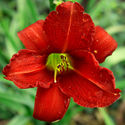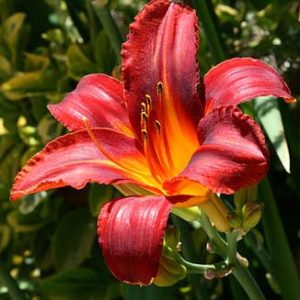By Max Phelps
In your landscaping, or in your flower or vegetable garden, consider the tough but lovely daylily. It’s versatile, comes in about every color but blue, and is super easy to grow. You should definitely consider growing this hardy perennial.
 The Latin for daylily is Hemerocallis. They are related to other lilies. Most hemerocallis species are from Asia, but hemerocallis fulva is a wild orange daylily found over much of America. There are over 80,000 registered daylily cultivars in the world now, and about 12,000 are available for purchase from lots of daylily growers and roadside markets, as well as by mail order. The American Hemerocallis Society is the certifying organization in the US.
The Latin for daylily is Hemerocallis. They are related to other lilies. Most hemerocallis species are from Asia, but hemerocallis fulva is a wild orange daylily found over much of America. There are over 80,000 registered daylily cultivars in the world now, and about 12,000 are available for purchase from lots of daylily growers and roadside markets, as well as by mail order. The American Hemerocallis Society is the certifying organization in the US.
The daylily plant is generally propogated by dividing an existing clump. One or more ‘fans’ are planted to begin a new plant. Part of a dormant root can also be planted. And, from seed, you might get an entirely new variety altogether if you have the patience.
Growing in moist or very dry conditions, in sun or part shade, in poor or rich soils, the daylily is one of the easiest plants for the beginner to have succes with. From a small plant or clump, the clump gets bigger as the years go by. Like all perennials, eventually it will do better if dug up and divided. (Sell, give away, or eat the extras, anyone?) Blooms come in spikes of a dozen or more buds, one flower opens and is in bloom for just one day. For several weeks a plant will bloom. And if it is a ‘rebloomer’, more shoots will come and there will be more blooms right up until cold weather.
Daylily plants are evergreen, semievergreen or dormant. (You don’t want to plant dormant ones in Florida or Southern Californiaand you don’t want to plant evergreen ones in North Dakota.) Most begin to bloom in either June or July, and produce for several days to a few weeks. Again, rebloomers will continue to bloom sporadically the remainder of the growing season. Most daylilies open in morning and are finished the same day. A few are nocturnal, meaning the blooms open late in the evening or at night and continue through the following day.
 With modern breeding programs by dozens of hybridizers, you can have about any size or color of daylily you want. Prices for fancy ones, rare ones, or newer cultivars may be a bit steep, but with so many varieties out there, even the most modest homeowner can buy a few from the ‘big box’ store at a reasonable price (or find a local grower or gardener with a ‘daylilies for sale’ sign, or beg or borrow a start from a neighbor). Landscapers typically use a common reblooming variety such as Stella d’Oro or Happy Returns. But with so many options, with a little research, there is no reason to limit ones design or planting to just the popular common ones. A massed planting of several complimentary colors with both early and late bloom times, making sure some are rebloomers, a landscaper or homeowner can have flowers constantly from late May until a hard freeze. Specimen or accent plantings where daylilies are used sparingly, but with a dramatic flare, can really put some pizzaz into a garden or landscape.
With modern breeding programs by dozens of hybridizers, you can have about any size or color of daylily you want. Prices for fancy ones, rare ones, or newer cultivars may be a bit steep, but with so many varieties out there, even the most modest homeowner can buy a few from the ‘big box’ store at a reasonable price (or find a local grower or gardener with a ‘daylilies for sale’ sign, or beg or borrow a start from a neighbor). Landscapers typically use a common reblooming variety such as Stella d’Oro or Happy Returns. But with so many options, with a little research, there is no reason to limit ones design or planting to just the popular common ones. A massed planting of several complimentary colors with both early and late bloom times, making sure some are rebloomers, a landscaper or homeowner can have flowers constantly from late May until a hard freeze. Specimen or accent plantings where daylilies are used sparingly, but with a dramatic flare, can really put some pizzaz into a garden or landscape.
Besides long blooming, low maintenance, and everybody’s favorite color (except blue)there must be a spot in your yard begging for a daylily.
What other value besides looks is there in a daylily? Well, they are pretty good at erosion control and weed suppression. And the obvious, but usually overlooked, is that they are edible!
In Asian markets, look for ‘gum jum’, golden needles, or ‘yellow flower vegetable’. The flowers are edible, the flower buds are especially delicious, and on most the leaves (blades) and also the nodules on the roots are edible. I invite the reader to pick a few large buds from a daylily plant and toss into their salad before they dismiss this notion that they are edible. Try it, I bet you’ll like it! Then, there is fried breaded flowers, pickled daylily buds and so on. The tubers where carbohydrates are stored (like tiny potatoes or peanuts) are also a good nutritious addition to a salad, soup, etc.
As Scripture says: “consider the lilies of the field…for even King Solomon in all his finery was not arrayed as one of these”!